Internal Organs—Overview
The solid areas are for description only; they do not represent Silver Points.
Location:
• Most of the internal organs project onto the concha.
• The organs of the upper half of the trunk (thoracic organs) are represented in the inferior concha (e.g., Lung Zone), while those of the lower half (abdominal organs) are represented in the superior concha (e.g., Intestine Zone).
Exceptions:
• The heart projects onto the antihelix (being a special type of striated muscle, it is represented in the reflex zone of the muscles).
• The reflex areas of kidneys and genitals are located underneath the ascending helix (their embryogenesis differs from that of other organs; the kidneys develop from the mesoderm).
• All blood and lymph vessels project basically near the structures that they supply (e.g., arm, leg).
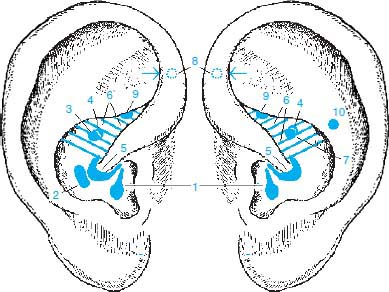
Fig. 3.1
1 Lung
2 Liver
3 Gall bladder
4 Pancreas
5 Stomach, esophagus, and duodenum
6 Intestine
7 Spleen
8 Kidney
9 Bladder
10 Heart
Heart
Location:
• In contrast to most internal organs the heart does not project onto the concha but is represented in the reflex area of the thoracic spine muscles (4th–7th ICS) because it is a special type of striated muscle.
• The motor portion is represented on the back of the ear and the sensory portion on the front of the ear.
Contrary to the usual forceps method, the motor portion of the Heart Zone is pricked with a gold needle (e.g., concomitant acupuncture therapy in case of myocardial insufficiency).
Blood Vessels
Location:
• The arteries and veins basically project near the structures that they supply (e.g., the femoral artery is represented in the Thigh Zone).
In ear acupuncture, the blood and lymph vessels rarely need to be treated. As the therapist can easily deduce their representations, these are not described here in detail. If a segment of a vessel is affected, the active points of the respective anatomical structure are searched for by means of point finder or VAS.
Lymph Vessels
Location:
• The lymph vessels basically project near the structures that they supply (e.g., arm, leg).
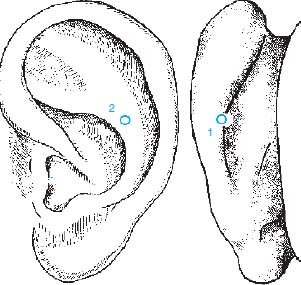
Fig. 3.2
1 Heart (motor portion)
2 Heart (sensory portion)

Fig. 3.3
Blood vessels
Lymph vessels
Respiratory System—Overview
Location:
• The reflex zone of the lung is located in the middle of the deepest site of the inferior concha.
• The reflex zones of bronchi, trachea, and throat (pharynx) are located in an obliquely superior direction toward the supratragic notch, with the trachea projecting parallel to the reflex zone of the esophagus.
Lung
Location:
• At the deepest site of the inferior concha (approximately in the middle of the inferior concha).
• The right lung projects onto the right ear and the left lung onto the left ear.
When considering the lung as an organ or as a functional system in the sense of TCM, a gold needle is used on the dominant ear.

Fig. 3.4
1 Lung
2 Bronchi
3 Trachea
4 Throat (pharynx)
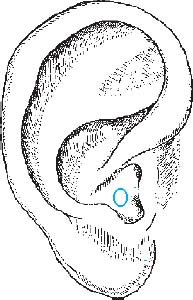
Fig. 3.5 Lung
Bronchi
Location:
• In the inferior concha, superior to the Lung Zone. Merges with the Trachea Zone.
When considering the bronchi as an organ or as a functional system in the sense of TCM, a gold needle is used on the dominant ear.
Trachea
Location:
• Superomedial to the Bronchi Zone, parallel to the Esophagus Zone in the direction of the Throat Point (at the superior end of this zone).
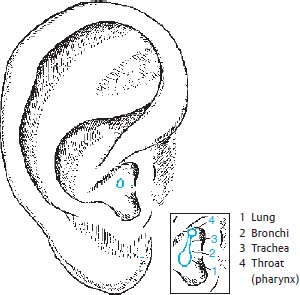
Fig. 3.6 Bronchi
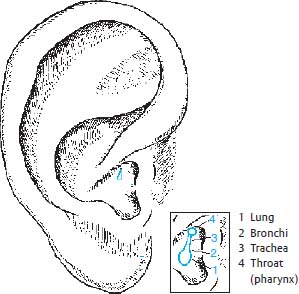
Fig. 3.7 Trachea
Throat (Pharynx)
Location:
• At the superior end of the Trachea Zone. If the vocal cords are affected active points will also be found here.

Fig. 3.8 Throat (pharynx)
Gastrointestinal System—Overview
The organs of the gastrointestinal system project onto the entire superior concha and the upper part of the inferior concha.
Depending on the position of the organs in the body, their reflex zones are found on either the right or the left ear, or on both ears (e.g., Stomach Zone, Pancreas Zone).
Again, sensory portions are represented on the front of the ear and motor portions on the back of the ear.
Esophagus
Location:
• At the medial end of the Stomach Zone (Cardia Zone) below the root of the helix. Tapering off in the direction of the Throat Point below the supratragic notch.
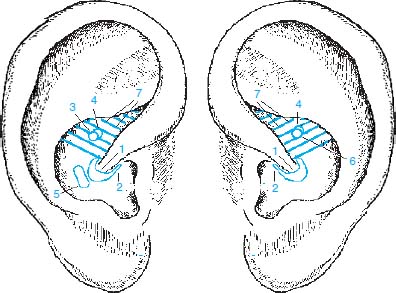
Fig. 3.9
1 Stomach, esophagus, and duodenum
2 Esophagus
3 Gall bladder
4 Pancreas
5 Liver
6 Spleen
7 Small/large intestine
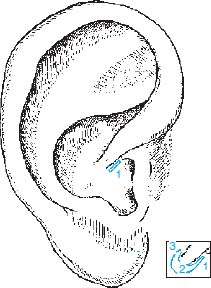
Fig. 3.10
1 Esophagus
2 Stomach
3 Duodenum
Stomach
Location:
• The Stomach Zone forms a crescent-shaped area around the root of the helix.
• There is a zone on the right ear and a larger zone on the left ear.
Duodenum
Location:
• In the superior concha adjacent to the reflex area of the posterior (inferior) end of the stomach, superolateral to the root of the helix.
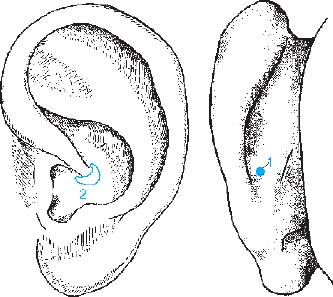
Fig. 3.11
1 Stomach (motor portion)
2 Stomach (sensory portion)

Fig. 3.12 Duodenum
1 Esophagus
2 Stomach
3 Duodenum
Jejunum/Ileum (Small Intestine)
Location:
• Upper and middle region of the superior concha, occupying the larger part of the superior concha (the Colon Zone and Rectum Zone are superolateral to it).
Colon (Large Intestine)
Location:
• In the upper part of the superior concha. On the back of the ear in the upper fifth of the auricle, about 3–4 mm away from the medial border.
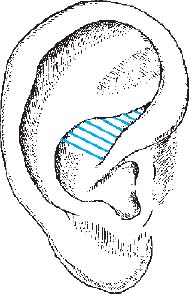
Fig. 3.13
Jejunum/ileum
(small intestine)
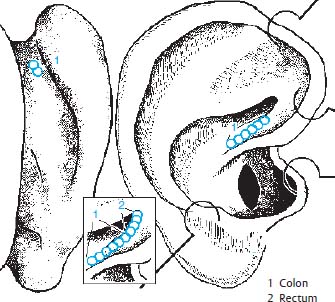
Fig. 3.14
Colon
(large intestine)
Appendix
Location:
• Underneath the root of helix in the corner formed by the helical crus against the concha, at the medial border of the superior concha.
• The zone’s location varies. This reflects the fact that the vermiform appendix extends upward behind the cecum in about 65 % of people, while it reaches into the small pelvis in about 30 %; it may also lie horizontally either in front of or behind the cecum.
• The size of the projection area depends on the size of the appendix in the body (2–20 cm in length).
•
Stay updated, free articles. Join our Telegram channel

Full access? Get Clinical Tree


